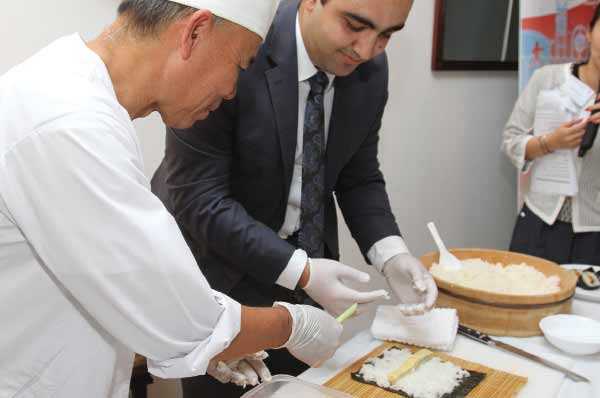Locals savour and indulge traditional Japanese cuisine
It is always advisable to try out cuisines from other parts of the world in case one finds oneself in those parts one day with nothing else to eat but the local foods. On a wet Thursday evening members of the press and an array of dignitaries had a rare opportunity to sample some of the finest Japanese cuisine on offer and a chance to learn how to make Sushi Rolls, Tempura as well as the famous Green Tea (or Maccha in Japanese).
Besides the Chopsticks, there is so much to learn and hear about Japanese cuisines. Renowed Chefs who have mastered the art of cooking traditional Japanese foods counsel that food is also meant to be enjoyed with the eyes instead of just the mouth. So in this case, since yours truly was not as adventurous to sample some of the delicacies on offer, but ate with her eyes and just marvelled at the skill and technique served on the platter. The host, Masahiro Onishi - the Japanese Ambassador to Botswana - informed the gathering that this is the third Japanese food demonstration they have hosted.
The event also marks the 50th anniversary of the Independence of Botswana as well as the diplomatic relations between the two countries. The Ambassador said that one of the reasons that Japanese food is popular abroad is because of the healthiness of its ingredients - mainly vegetables and seafood.
“Another appealing factor of the typical Japanese food is the delicate and beautiful presentation of dishes by a skilled Chef. We have an expression eat by eyes and we enjoy not only taste of food but also arrangement of each dish,” he explained. Before guests were given the opportunity to sample some of the dishes that were prepared by the Resident Chef to the Embassy, he demonstrated two dishes that appear to be popular in Japan.
First up was making Sushi Rolls, which on the surface looks easy, but in fact is not the case. There are too many techniques, and one needs patience in order to make this dish. Next up was making Nigiri Sushi - a demonstration that afforded those interested in learning more about Japenese cuisines with a free cooking lesson and tips. What is interesting once one starts to research about these cuisines is that apart from making it into the UNESCO’s Intangible Cultural Heritage list in 2013 is the fact that a Sushi Chef trains for 10 years before he can serve Japanese food in a restaurant.
Another interesting development is that like a Samurai, the blade of a professional Sushi Chef’s knife must be re-sharpened every day. This according to sources is vital when working with Sashimi - a raw, thinly sliced fish. Something worth noting is that most Sushi Chefs consider making Sushi Rice an art. According to information sourced from http://www.yamato.co.za// Japanese Food is cooked perfectly when it is slightly sticky to the touch.
But a hit for tea lovers was witnessing a tea serving ceremony. For a tea drinker this is one of those rare opportunities where one had to forget about brands that are flooding the market and to experience something different. And those who did were not disappointed.
While Maccha, a dark green tea is not consumed with sugar, a clever trick that the Japenese use is eating a sweet before indulging in the tea. And trust us when we tell you that you will not even miss sugar in your tea. The process of making this tea which can be purchased from Chinese stores or even Woolworths is a delicate one, a process that is not rushed.
Fun Facts
In Japanese food terminology, the word “sushi’ actually refers to vinegar rice, and not fish, while the word “sashimi” means pierced flesh.






